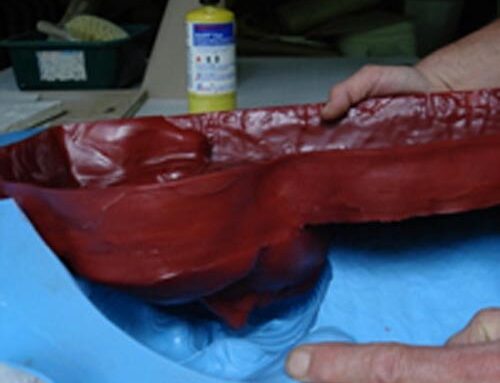A Glass Work In Progress | Part III
Questions And Answers – A Conversation with Mike Leckie, Sculptor
May 27 – 2007
 The wax model is in the plywood box behind my head. Those sides are put together with wax to hold them together. The wax is a good medium. It’s so easy to use when its liquid and it dries hard. It’s also temporary, it can be broken up easily.
The wax model is in the plywood box behind my head. Those sides are put together with wax to hold them together. The wax is a good medium. It’s so easy to use when its liquid and it dries hard. It’s also temporary, it can be broken up easily.
I’m putting plaster in one of 7 buckets that I’m mixing for the mold….the mold was that big. By the time we were lifting the mold we figured it was between 120 and 140 pounds.
It’s a very specific mixture of plaster, silica flour, water and
chopped fiberglass cloth…a closely guarded formula, of course…actually
you can find it in a book. Lots of extra fiberglass fiber for
reinforcement. The fiberglass cloth is also.
 All of those buckets need to be made very carefully at approximately
All of those buckets need to be made very carefully at approximately
the same time so that when the mixture goes from liquid to solid….it
all happens at the same time or it doesn’t work because some of the
plaster has gone off and some of it hasn’t…from liquid to hard…it’s a
chemical reaction.
 What I’m doing here is painting water on the wax mold because the capillary action of the water will pull the plaster mix into the detail. I’m painting all the detail of the piece.
What I’m doing here is painting water on the wax mold because the capillary action of the water will pull the plaster mix into the detail. I’m painting all the detail of the piece.
This is the pouring process. I have the bucket up really high held with one hand and I’m pouring into my hand because if you pour into your hand, it goes back to the wall of the piece and you get a lot less bubbles. Bubbles are the bane of a caster because the bubble will end up being a positive on the piece. If it’s a negative in the plaster, it will be a positive in the piece.
 The fiberglass is also silica. I’m wearing the mask because almost everything in the mix except for the plaster and the water will kill me if I breathe it. The silicon flower is 300 mesh silica which is silica powder. If you breathe it your lungs are not able to expel it. It actually forms scar tissue
The fiberglass is also silica. I’m wearing the mask because almost everything in the mix except for the plaster and the water will kill me if I breathe it. The silicon flower is 300 mesh silica which is silica powder. If you breathe it your lungs are not able to expel it. It actually forms scar tissue
around every particle of silica and so your lungs end up being all
scar tissue instead of air sac.

I’m pouring up to depth. You can still see the base and the nose and the mouth on
one of the faces. We will go two and a half to three inches over that base
to get the proper depth for the mold.
I am placing the fiberglass cloth, which you can see on the surface. I let it get damp and then I take them piece by piece and put them at all of the stress points in the mold. They go around the outside edges, across the flat surfaces. You can’t have them touching the wax piece, they have to be suspended in the plaster. It strengthens the mold. I fire higher than the temperature that is good for the plaster so you have to do everything you can to help the plaster.
It’s not difficult to get the plaster off of my arms. You just dip them in water and it comes off.


